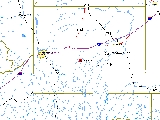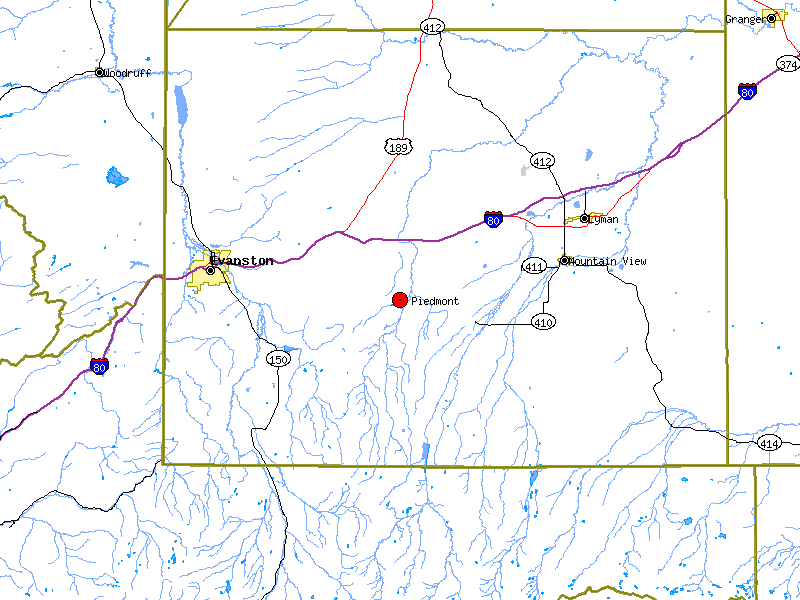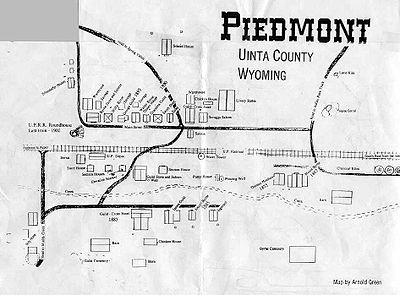
Piedmont, Wyoming
Encyclopedia
Piedmont is a ghost town
located in Uinta County, Wyoming
. It was once a thriving small railroad and timber town, but started to decline when Union Pacific opened a new line that bypassed the town.
Many sources will provide other coordinates for this town, but they usually point to Ft. Bridger, Wyoming, which is the nearest city.

, was settled about 1867 to provide railroad tie
s for the Union Pacific Railroad
. Moses Byrne built several kiln
s here for producing charcoal
, and Charles Guild established one of the first ranches in the Territory. Both Byrne and Guild were Mormon
pioneers.
Originally, the area was named "Byrne
," but due to confusion with Bryan Station was renamed Piedmont. Both Byrne's wives, Anne Beus and Catherine Cardon, and Guild's wife, Marie Madeleine Cardon, were from small towns in the Torino Province, part of the Piedmont
Region of northern Italy
. Moses' wife Anne Beus lived in Ogden, Utah
, and his other wife Catherine Cardon eventually ended up living in Piedmont, after first having spent time in the Utah towns of Ogden and Slaterville. Most historical sources that reference both 'Mrs. Byrne' and Piedmont are taken to be referring to Catherine Cardon. Catherine Cardon Byrne and Marie Madelaine Cardon Guild were sisters.
The Guild family joined the Byrne family in 1866 at the Muddy River Station in southwest Wyoming, having traveled from Salt Lake City. As the transcontinental railroad moved into western Wyoming, a wood and water station was needed, and it was found that a spot approximately five miles west of the Muddy River station was ideal, being situated in the direct line of the track. Moses Byrne was asked to run the station. It was thought at first that they would call it Byrne, but it was later decided that the name might be confusing, since there was a station called Bryan west of Green River.
Piedmont, a typical tent camp for the railroad, probably at this time knew its greatest population; yet there is evidence of only approximately twenty homes. The tent town served as a base camp for the graders who were constructing a roadbed up the steep side of the mountain to the summit called Aspen Station.
The route for the railroad had many sharp curves, including a full horseshoe bend. By 1868, the railroad crew arrived to lay track on the prepared roadbed. It was soon realized that helper engines would be needed on the eight-mile grade. Wells that were dug provided plentiful water. Sidings, an engine shed, and a water tank were constructed, and Piedmont became a wood and water refueling station for helper engines.
Men were needed to run the helper engines, so more families moved in. There were also homesteaders arriving at that time. The Guilds opened a mercantile establishment, and the town boasted four saloons.
The logging industry, as a commercial venture, became well established in Piedmont as well. Moses Byrne constructed charcoal kilns in Piedmont during 1877. Five in total were built, at a cost of fifteen hundred dollars. Quaking aspen and pine logs were hauled by ox teams to the kilns where they were burned into charcoal. The Union Pacific Railroad Company used the charcoal as fuel for the passenger cars. The three surviving Piedmont Charcoal Kilns
were listed on the National Register of Historic Places
in 1971.
crossed Promontory Summit in Utah and stopped just a few feet short of the Union Pacific tracks. The north side of the rails were joined, but those on the south side were left for the driving of the golden spike. On May 7, Promontory was overflowing with discharged workers; tent saloons were stocked, and the women arrived. A special train from Sacramento had arrived with all the dignitaries of the Central Pacific Railroad.
Things weren't going quite so well on the Union Pacific train. In Piedmont, there were three hundred graders and tie cutters who had been discharged but not paid. The story was circulated that the financing of the railroad had collapsed and that, upon completion of the railroad, the Union Pacific would receive a government subsidy. This would bankrupt the grading and tie contractors.
They enlisted the aid of a telegrapher to let them know of the arrival of the special train in Piedmont. There the train met an obstacle of ties on the track, and by the time the ties were cleared off, the special car carrying the financial wizard and the Union Pacific vice president was side railed, leaving the rest of the train to go on. A telegram was finally sent by the detained men that resulted in two hundred thousand dollars being sent to give the workers their back pay. Another telegraph was sent to Promontory with the message that the dignitaries would not arrive there until May 10. When the money arrived at Piedmont, the train car was re-coupled and sent on its way. The golden spike was driven on Monday, May 10, 1869.
It was later reported that a Salt Lake banker sent a telegram to Fort Bridger
for troops to go into Piedmont, but a telegrapher took the message off and no troopers were sent.
Robert Fulton, a telegrapher in Rawlins, Wyoming
, in 1869, established the date of the hijacking as being May 7. Some historians disagree on the date, but in any case newspaper accounts of the holdup brought temporary fame to Piedmont.
In 1940, lack of business forced the closing of the old Guild Mercantile Store. Since then, most of the buildings have been hauled away. All that remains are three or four tumbledown remnants of homes, some foundations, the coal dump where the engine shed once stood, the charcoal kilns of Moses Byrne, and the cemeteries.

Ghost town
A ghost town is an abandoned town or city. A town often becomes a ghost town because the economic activity that supported it has failed, or due to natural or human-caused disasters such as floods, government actions, uncontrolled lawlessness, war, or nuclear disasters...
located in Uinta County, Wyoming
Uinta County, Wyoming
-Demographics:As of the census of 2000, there were 19,742 people, 6,823 households, and 5,144 families residing in the county. The population density was 10 people per square mile . There were 8,011 housing units at an average density of 4 per square mile...
. It was once a thriving small railroad and timber town, but started to decline when Union Pacific opened a new line that bypassed the town.
Geography
Piedmont is located at 41°13'4.04" North, 110°37'40.02" West (41.21779, -110.62778).Many sources will provide other coordinates for this town, but they usually point to Ft. Bridger, Wyoming, which is the nearest city.

History
Piedmont, located southeast of EvanstonEvanston, Wyoming
Evanston is a city in Uinta County, Wyoming, United States. The population was 12,359 at the 2010 census. It is the county seat of Uinta County.-Geography:Evanston is located at...
, was settled about 1867 to provide railroad tie
Railroad tie
A railroad tie/railway tie , or railway sleeper is a rectangular item used to support the rails in railroad tracks...
s for the Union Pacific Railroad
Union Pacific Railroad
The Union Pacific Railroad , headquartered in Omaha, Nebraska, is the largest railroad network in the United States. James R. Young is president, CEO and Chairman....
. Moses Byrne built several kiln
Kiln
A kiln is a thermally insulated chamber, or oven, in which a controlled temperature regime is produced. Uses include the hardening, burning or drying of materials...
s here for producing charcoal
Charcoal
Charcoal is the dark grey residue consisting of carbon, and any remaining ash, obtained by removing water and other volatile constituents from animal and vegetation substances. Charcoal is usually produced by slow pyrolysis, the heating of wood or other substances in the absence of oxygen...
, and Charles Guild established one of the first ranches in the Territory. Both Byrne and Guild were Mormon
Mormon
The term Mormon most commonly denotes an adherent, practitioner, follower, or constituent of Mormonism, which is the largest branch of the Latter Day Saint movement in restorationist Christianity...
pioneers.
Originally, the area was named "Byrne
Byrne
Byrne meaning 'raven', is derived from the Irish name Ó Broin, and is the seventh most common surname in Ireland today.-History:...
," but due to confusion with Bryan Station was renamed Piedmont. Both Byrne's wives, Anne Beus and Catherine Cardon, and Guild's wife, Marie Madeleine Cardon, were from small towns in the Torino Province, part of the Piedmont
Piedmont
Piedmont is one of the 20 regions of Italy. It has an area of 25,402 square kilometres and a population of about 4.4 million. The capital of Piedmont is Turin. The main local language is Piedmontese. Occitan is also spoken by a minority in the Occitan Valleys situated in the Provinces of...
Region of northern Italy
Italy
Italy , officially the Italian Republic languages]] under the European Charter for Regional or Minority Languages. In each of these, Italy's official name is as follows:;;;;;;;;), is a unitary parliamentary republic in South-Central Europe. To the north it borders France, Switzerland, Austria and...
. Moses' wife Anne Beus lived in Ogden, Utah
Ogden, Utah
Ogden is a city in Weber County, Utah, United States. Ogden serves as the county seat of Weber County. The population was 82,825 according to the 2010 Census. The city served as a major railway hub through much of its history, and still handles a great deal of freight rail traffic which makes it a...
, and his other wife Catherine Cardon eventually ended up living in Piedmont, after first having spent time in the Utah towns of Ogden and Slaterville. Most historical sources that reference both 'Mrs. Byrne' and Piedmont are taken to be referring to Catherine Cardon. Catherine Cardon Byrne and Marie Madelaine Cardon Guild were sisters.
The Guild family joined the Byrne family in 1866 at the Muddy River Station in southwest Wyoming, having traveled from Salt Lake City. As the transcontinental railroad moved into western Wyoming, a wood and water station was needed, and it was found that a spot approximately five miles west of the Muddy River station was ideal, being situated in the direct line of the track. Moses Byrne was asked to run the station. It was thought at first that they would call it Byrne, but it was later decided that the name might be confusing, since there was a station called Bryan west of Green River.
Piedmont, a typical tent camp for the railroad, probably at this time knew its greatest population; yet there is evidence of only approximately twenty homes. The tent town served as a base camp for the graders who were constructing a roadbed up the steep side of the mountain to the summit called Aspen Station.
The route for the railroad had many sharp curves, including a full horseshoe bend. By 1868, the railroad crew arrived to lay track on the prepared roadbed. It was soon realized that helper engines would be needed on the eight-mile grade. Wells that were dug provided plentiful water. Sidings, an engine shed, and a water tank were constructed, and Piedmont became a wood and water refueling station for helper engines.
Men were needed to run the helper engines, so more families moved in. There were also homesteaders arriving at that time. The Guilds opened a mercantile establishment, and the town boasted four saloons.
The logging industry, as a commercial venture, became well established in Piedmont as well. Moses Byrne constructed charcoal kilns in Piedmont during 1877. Five in total were built, at a cost of fifteen hundred dollars. Quaking aspen and pine logs were hauled by ox teams to the kilns where they were burned into charcoal. The Union Pacific Railroad Company used the charcoal as fuel for the passenger cars. The three surviving Piedmont Charcoal Kilns
Piedmont Charcoal Kilns
The Piedmont Charcoal Kilns in Piedmont, Wyoming are a remnant of a once-extensive charcoal-making industry in southwestern Wyoming. The kilns were built by Moses Byrne around 1869 near the Piedmont Station along the Union Pacific Railroad. The three surviving beehive-shaped kilns were built of...
were listed on the National Register of Historic Places
National Register of Historic Places
The National Register of Historic Places is the United States government's official list of districts, sites, buildings, structures, and objects deemed worthy of preservation...
in 1971.
Piedmont and the Golden Spike
On May 5, 1869, the Central Pacific RailroadCentral Pacific Railroad
The Central Pacific Railroad is the former name of the railroad network built between California and Utah, USA that formed part of the "First Transcontinental Railroad" in North America. It is now part of the Union Pacific Railroad. Many 19th century national proposals to build a transcontinental...
crossed Promontory Summit in Utah and stopped just a few feet short of the Union Pacific tracks. The north side of the rails were joined, but those on the south side were left for the driving of the golden spike. On May 7, Promontory was overflowing with discharged workers; tent saloons were stocked, and the women arrived. A special train from Sacramento had arrived with all the dignitaries of the Central Pacific Railroad.
Things weren't going quite so well on the Union Pacific train. In Piedmont, there were three hundred graders and tie cutters who had been discharged but not paid. The story was circulated that the financing of the railroad had collapsed and that, upon completion of the railroad, the Union Pacific would receive a government subsidy. This would bankrupt the grading and tie contractors.
They enlisted the aid of a telegrapher to let them know of the arrival of the special train in Piedmont. There the train met an obstacle of ties on the track, and by the time the ties were cleared off, the special car carrying the financial wizard and the Union Pacific vice president was side railed, leaving the rest of the train to go on. A telegram was finally sent by the detained men that resulted in two hundred thousand dollars being sent to give the workers their back pay. Another telegraph was sent to Promontory with the message that the dignitaries would not arrive there until May 10. When the money arrived at Piedmont, the train car was re-coupled and sent on its way. The golden spike was driven on Monday, May 10, 1869.
It was later reported that a Salt Lake banker sent a telegram to Fort Bridger
Fort Bridger
Fort Bridger was originally a 19th century fur trading outpost established in 1842 on Blacks Fork of the Green River and later a vital resupply point for wagon trains on the Oregon Trail, California Trail and Mormon Trail. The Army established a military post here in 1858 during the Utah War until...
for troops to go into Piedmont, but a telegrapher took the message off and no troopers were sent.
Robert Fulton, a telegrapher in Rawlins, Wyoming
Rawlins, Wyoming
Rawlins is a city in Carbon County, Wyoming, United States. The population was 8,538 at the 2000 census. It is the county seat of Carbon County...
, in 1869, established the date of the hijacking as being May 7. Some historians disagree on the date, but in any case newspaper accounts of the holdup brought temporary fame to Piedmont.
The End of Piedmont as a Viable Town
About 1910, the Union Pacific Railroad began digging the Aspen tunnel through Aspen mountain. The completion of the tunnel—approximately one and one-half miles long—resulted in the elimination of the steep, winding grade from Piedmont to Aspen Station. The railroad was rerouted from LeRoy to the tunnel, missing Piedmont by several miles. Piedmont was stranded, and its demise began.In 1940, lack of business forced the closing of the old Guild Mercantile Store. Since then, most of the buildings have been hauled away. All that remains are three or four tumbledown remnants of homes, some foundations, the coal dump where the engine shed once stood, the charcoal kilns of Moses Byrne, and the cemeteries.
Layout of Town


